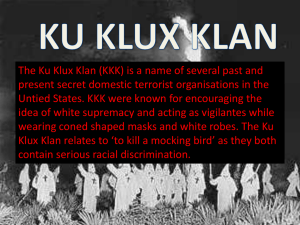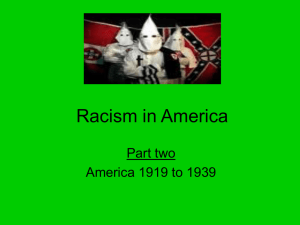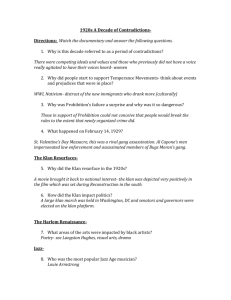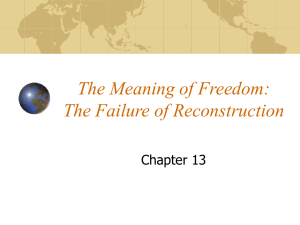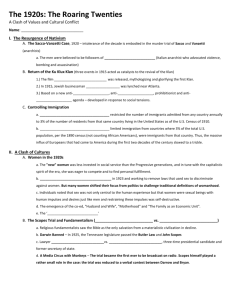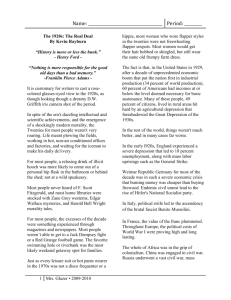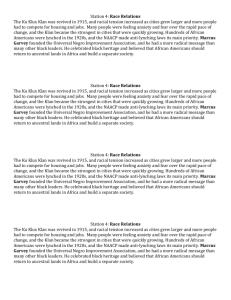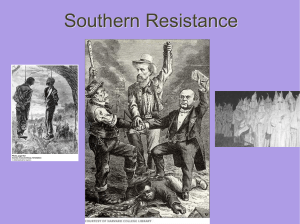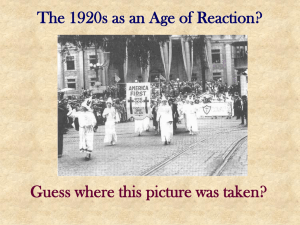word - Indiana University
advertisement
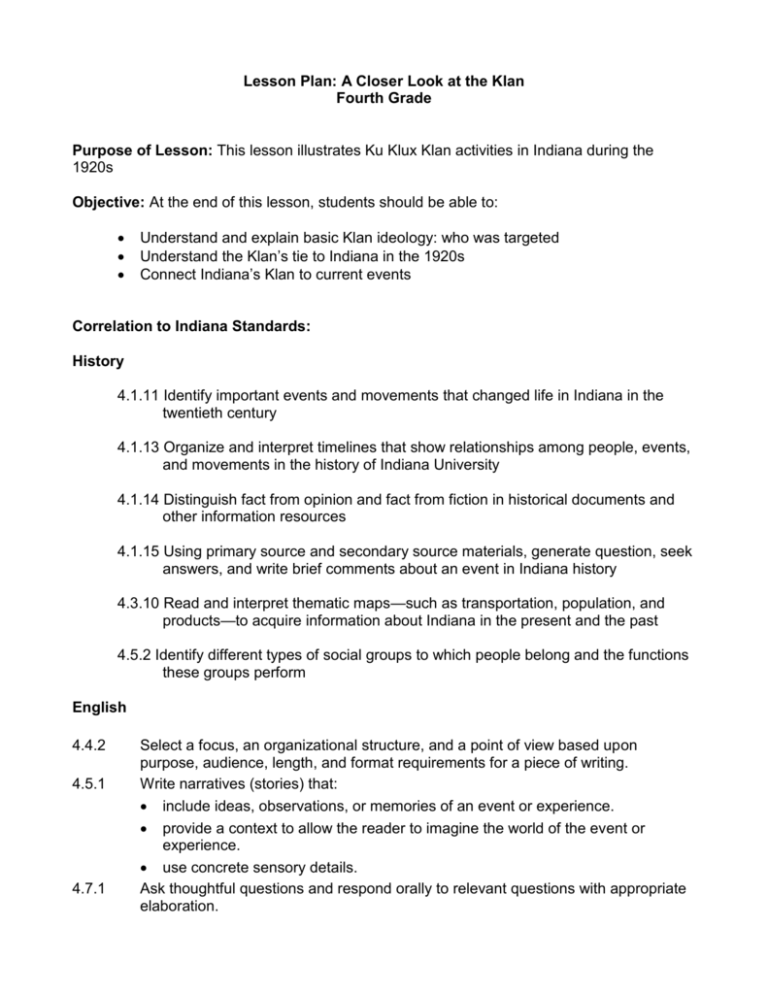
Lesson Plan: A Closer Look at the Klan Fourth Grade Purpose of Lesson: This lesson illustrates Ku Klux Klan activities in Indiana during the 1920s Objective: At the end of this lesson, students should be able to: Understand and explain basic Klan ideology: who was targeted Understand the Klan’s tie to Indiana in the 1920s Connect Indiana’s Klan to current events Correlation to Indiana Standards: History 4.1.11 Identify important events and movements that changed life in Indiana in the twentieth century 4.1.13 Organize and interpret timelines that show relationships among people, events, and movements in the history of Indiana University 4.1.14 Distinguish fact from opinion and fact from fiction in historical documents and other information resources 4.1.15 Using primary source and secondary source materials, generate question, seek answers, and write brief comments about an event in Indiana history 4.3.10 Read and interpret thematic maps—such as transportation, population, and products—to acquire information about Indiana in the present and the past 4.5.2 Identify different types of social groups to which people belong and the functions these groups perform English 4.4.2 4.5.1 4.7.1 Select a focus, an organizational structure, and a point of view based upon purpose, audience, length, and format requirements for a piece of writing. Write narratives (stories) that: include ideas, observations, or memories of an event or experience. provide a context to allow the reader to imagine the world of the event or experience. use concrete sensory details. Ask thoughtful questions and respond orally to relevant questions with appropriate elaboration. 4.7.11 Make narrative (story) presentations that: relate ideas, observations, or memories about an event or experience. provide a context that allows the listener to imagine the circumstances of the event or experience. provide insight into why the selected event or experience should be of interest to the audience. Historical and Methodological Context for the Lesson: During the 1920s, five million Americans joined the Ku Klux Klan. Hoosiers turned out in record numbers, making Indiana’s Klan the largest, most enthusiastic, and most politically powerful Klan in the country. Between one-fourth and one-third of native-born white Hoosier males joined the group (see document 5), and there were auxiliary organizations for women and children. At its peak in 1925, Indiana’s Klan could boast more members than the Methodist Church, the state’s leading denomination. This “second” Klan was organized in 1915 in Atlanta. In 1920, the southern group began a national publicity campaign, and the first Indiana chapter opened in Evansville in the fall of that year. A few people joined, but then a huge membership drive led by D. C. Stephenson from 1922-1924 brought in 118,000 members across the state (see document 6). Stephenson moved to Indianapolis and started a newspaper, The Fiery Cross, which ran from December 1922 to February 1925. In 1924, Klan numbers overwhelmed the state’s Republican Party and elected the governor (Ed Jackson), a majority in both houses of the legislature, and nearly all of the state’s thirteen congressmen. The Klan’s legislative program for 1925—directed against parochial schools and Catholic influence in public schools—was a complete failure. But other problems proved more pressing. D. C. Stephenson, the leader (Grand Dragon) of the Klan in the state since 1923, was a charming personality and powerful orator; he was also arrogant, cunning, evil, and hedonistic. Early in 1925, he assaulted, raped, and held captive his young secretary Madge Oberholtzer, who took poison and died one month later. Stephenson was indicted, and when Governor Jackson (who had now distanced himself from the Klan) refused to pardon him, Stephenson leaked information that to Jackson’s trial for bribery (the governor was acquitted on a technicality). As a political influence, the Klan faded quickly in Indiana, but its social and cultural influence dovetailed more subtly into Hoosier life. Klan literature capitalized on American racism, nativism, patriotism, and traditional moral and family values. Klan members targeted blacks, Catholics, and Jews, but also immigrants, political radicals, feminists, intellectuals, gamblers, bootleggers, thrill-seeking teenagers, and motion picture producers (see document 7). In one sense, Indiana’s Klan was a populist organization: it engaged community interests, presented a program of action, and promised political changes. The Klan’s message of patriotism, American superiority, and Protestant Christianity united native-born Hoosiers across many lines—gender, geography (north and south), class (white and blue collar), religious (many denominations of Protestants), and residential (urban and rural). But this populist club also propagated a negative and wicked influence. Klan members committed no lynching in Indiana, but their marches, burned crosses, brazen publications, and boycotts of community businesses evoked fear, intimidation, and lifelong trauma (see documents 2-4). Historian James Madison has observed that Indiana’s Klan “cannot be dismissed as either an aberration or as simply the insidious appeal of a fanatical few. Nor should the Klan be seen as thoroughly dominating the state and accurately reflecting racist, violent, or provincial beliefs shared for all time by all Hoosiers” (The Indiana Way, 291). Somewhere in the middle we find the meaning of the Klan in Indiana history. Lutholtz, M. William. Grand Dragon: D. C. Stephenson and the Ku Klux Klan in Indiana. West Lafayette, Ind., 1991. Madison, James H. The Indiana Way: A State History. 1986; Bloomington: Indiana University Press, 1990. [Pp. 289-95 provide an overview of the 1920s Klan in Indiana] Moore, Leonard J. Citizen Klansmen: The Ku Klux Klan in Indiana, 1921-1928. Chapel Hill: UNC Press, 1991. [A social and statistical analysis of Klan appeal and activity] Trelease, Allen W. White Terror: The Ku Klux Klan Conspiracy and Southern Reconstruction. New York, 1971. [Standard history of the post-Civil War Klan] Lesson Activities and Assessment: 1. Self-start. Show a picture of the Klan and ask: What is this about? Who is targeted? What do you know? Discuss with the class. 2. Vocabulary activity. Explain or define the words with a matching activity: adulterer, bootlegger, Christian, immigrant, Ku Klux Klan, nativism, parochial school, prohibition, Protestant, Roaring Twenties, Roman Catholic, segregation 3. Thought questions. How many Hoosier joined the Klan? Why was the Klan so popular? What appealed to people? Who did the Klan target? What did they do? What did victims experience? What does the Klan mean to Indiana history? What does it mean to Indiana residents in 2006? 4. Writing. After reading the reminiscence of the Klan parade (document 4), write a possible discussion between Ralph Dolezal and his parents after he returned home from the parade. Assume the character of Ralph (write in first person) and discuss what it means to the family, to the town, how you feel about going to school, how you will interact with other kids. 5. Symbols. Identify the visual symbols used by the Klan. What do they mean? Research other forms of propaganda online. Write a page comparing Klan symbols with symbols from other time periods. 6. Oral history. Find out the percentage of Klan participation in your county (document 5). Interview people in the community about Klan activities they have heard about. 7. Field trip. View the Thomas Hart Benton Murals at the Indiana University auditorium and Woodburn Hall. Should the picture of the Klan continue to be displayed in a public building? Historical Documents: Document 1 – Klan Members in Robes Godfrey Klan No. 93, Hartford City, Ind. (P 0411), Photo Subject Collection, Indiana Historical Society. Document 2 – A Fiery Cross Ku Klux Klan Cross Burning, Indianapolis Recorder Collection (P 0303) box 18, folder 14, Indiana Historical Society. Document 3 – A Klan Parade Parade at Anderson, 1922, W. A. Swift Photograph Collection, Ball State University Archives and Special Collections. Document 4 – A Klan Victim Remembers a Parade “During the summer of 1924 the Ku Klux Klan carried out four distinct aggressive actions in the northern Indiana town of North Judson. I was a lad of ten years at the time; I watched two of these events unfold before my eyes and I witnessed the results of all of them in the days that followed. A fiery cross, a public parade, a homemade bomb, and open vandalism—these vicious acts threatened all of the Catholics in our community. They left permanent scars in my memory that have not been erased in the intervening eight decades . ... “I knew these people; I delivered newspapers to their doors; I went to high school with their children. In face-to-face encounters I never felt threatened by them. Yet these acts were committed acts behind a veil of secrecy. It has been said of Indiana’s Klan-marked past that ‘You can’t burn history.’ You cannot wash it away with your tears either. My own feelings at this late date are somewhat ambivalent, possibly modified with time. I present these incidents here not to condemn anyone, but only to record a bit of history not previously put to print . . . . “The town’s only newspaper, the North Judson News, used the word ‘orderly’ to describe the Klan’s next act--an impressive parade routed down the extent of Lane Street, the principal buisness street of town. Beginning after nine o’clock p.m. on Thursday, July 24, 1924, it was more or less typical of such shows of strength used to intimidate the targets of the Klan. I watched it from the corner of Adair and Lane Streets with my classmate, Ralph Dolezal. I remember companies of marchers in white robes topped with the conical white hats and masks that covered their faces. These were preceded by numbers of similarly costumed members mounted on horses. Many were carrying flaming torches that added emphasis to the eerie and threatening spectacle. More than anything else, however, the most striking and impressive part of the parade was a float of a ‘Little Red Schoolhouse’—a public school. The attached labeling left no doubt as to what was being targeted—our parochial school! To a ten-year-old schoolboy this was a body blow.” (Excerpts from an unpublished memoir, in preparation for publication in the Indiana Magazine of History) Document 5 – Indiana Klan Membership by County (Leonard J. Moore, Citizen Klansmen [1991], 54) Document 6 – Membership Growth of the Indiana Klan (Leonard J. Moore, Citizen Klansmen [1991], 17) Document 7 – Klan Enemies “At the top of the list of enemies were Roman Catholics. Centuries-old tales and prejudices revived under Klan propaganda, with emphasis on a foreign-led church intent on destroying Protestantism and American democracy. The foreign-born themselves constituted a second Klan enemy, for they too threatened Protestantism and democracy. Blacks were a third enemy, though less dangerous than Catholics, except in a few cities where their segregated neighborhoods were expanding. And the enemy included all those immoral and indecent Hoosiers who put the roar into the Roaring Twenties: adulterers, gamblers, prohibition violators, corrupt politicians, and undisciplined youth.” (James H. Madison, The Indiana Way [1990], 292) Document 8 – Accounting for the Klan Indiana’s Klan “cannot be dismissed as either an aberration or as simply the insidious appeal of a fanatical few. Nor should the Klan be seen as thoroughly dominating the state and accurately reflecting racist, violent, or provincial beliefs shared for all time by all Hoosiers.” (James H. Madison, The Indiana Way [1990], 291) Document 9 – Indiana Population, 1900-1930 Year 1900 1910 1920 1930 Total 2,516,462 2,700,876 2,930,390 3,238,503 White % Black % Foreign Born 2,458,502 97.69 57,505 2.28 142,121 2,639,961 97.74 60,320 2.23 159,663 2,849,071 97.22 80,810 2.75 150,868 3,116,136 96.22 111,982 3.45 135,134 (James H. Madison, The Indiana Way [1990], 325-29) % 5.64 5.91 5.14 4.17
